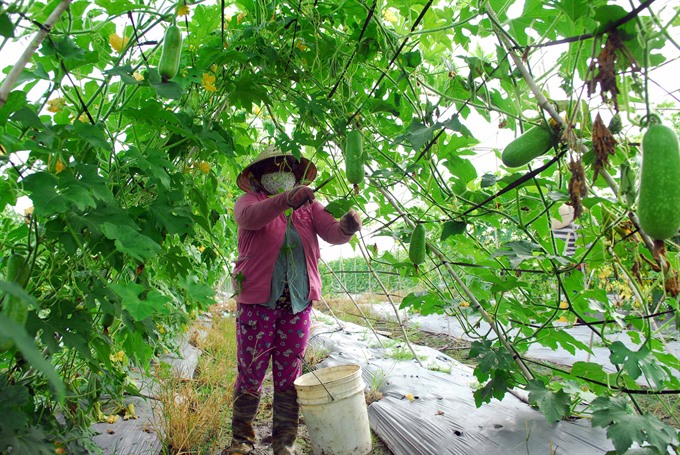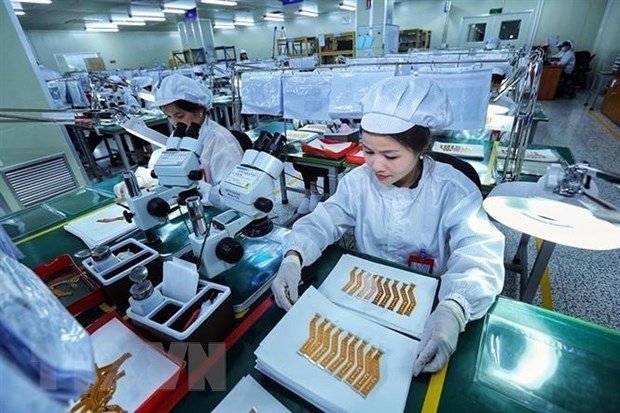 Economy
Economy

Despite many difficulties, the production value of HCM City’s agro-forestry and fishery sectors increased by 5.8 per cent last year, reaching VNĐ19.59 trillion (US$859.5 million), according to the city Department of Agriculture and Rural Development.
 |
| A farmer takes care the fresh vegetable garden at Củ Chi District, HCM City. The city’s vegetable cultivation last year reached 15,370 ha, up 9.5 per cent over 2015, yielding more than 419,100 tonnes of vegetables, a year-on-year increase of 18 per cent.- VNA/VNS Photo Mạnh Linh |
HCM CITY — Despite many difficulties, the production value of HCM City’s agro-forestry and fishery sectors increased by 5.8 per cent last year, reaching VNĐ19.59 trillion (US$859.5 million), according to the city Department of Agriculture and Rural Development.
The increase was much higher than the country’s average growth of 1.44 per cent, it said.
Speaking at a meeting in HCM City last week to review the city’s agricultural sector performance last year and set tasks for this year, department director Nguyễn Phước Trung said the production value of the cultivation sector grew by 3.9 per cent, the animal husbandry sector by 4.5 per cent and the seafood sector by 7.7 per cent.
This was a result of following an urban agricultural model, reducing rice-growing areas of low productivity, and increasing the area for cultivating high-value ornamental trees and safe vegetables as well as dairy farming, he said.
Vegetable cultivation last year reached 15,370 ha, up 9.5 per cent over 2015, yielding more than 419,100 tonnes of vegetables, a year-on-year increase of 18 per cent.
The city had around 2,300 ha under flower and ornamental tree cultivation last year, up 2.2 per cent over 2015, he said.
Trung said the city had a total of 152,744 cows, a year-on-year decrease of 0.7 per cent, with the number of milk cows down but the number of meat cows up.
The city also has 360,000 pigs, equalling the figure of 2015, he said, adding that total aquaculture and seafood output went up by 4.6 per cent over the previous year.
The number of ornamental fish reached 135 million, up by 35 per cent over the preceding year, of which, 16 million were exported for a value of $16.53 million, a year-on-year increase of 17.8 per cent of volume and 35.8 per cent of value, he said.
In addition, the city exported seeds and seedlings, ornamental trees, fruits and vegetables and crocodiles to many countries and territories, he said.
Targets for 2017
For this year, the agricultural sector will strive to achieve 6 per cent growth in agro-forestry and fishery production, Trung said.
To achieve the target set for this year, he said the city would continue its agricultural restructuring programme towards urban agriculture, especially enhancing the application of hi-tech methods including biotechnology in production to provide safe and high quality products.
The city will also support agricultural producers and traders in building brands and trade promotion programmes to promote exports of their products, he said, adding that it will work to encourage more businesses to invest in the agricultural sector and improve human resources, he said.
Trương Văn Bảo, director of Veeteq Farm, said investing in fruit and vegetable farms with high technology as well as preliminary processing facilities and distribution systems for these products requires a large amount of investment capital.
But firms still encountered difficulties in accessing preferential capital sources and policies, he said.
He suggested the authorities should offer incentives to enterprises involved in hi-tech agricultural production in terms of investment capital as well as support them for costs for testing product quality.
Lê Đình Đức, deputy chairman of the Củ Chi People’s Committee, suggested the city should have policies that encourage businesses that have succeeded in applying hi-tech in their agricultural production to link and transfer technologies to farmers and buy products from farmers.
He also suggested establishing a system of forecasting supply and demand and prices of agricultural products to prevent the problem of a bumper crop leading to falling prices. — VNS









